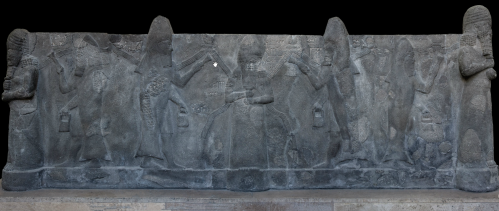Kvanvig: Adapa Breaks the Wing of the South Wind
“Izre’el thus finds a structural level in the myth deeper than concerns about the figure of Adapa and his relationship to wisdom, language, and magic, and further, his role as the primary apkallu and patron of the magicians. In this deep level the myth symbolizes all humanity on their way to insight and maturity.
We will not object to the possibility of reading myths in this way. In this deeper level we see traits that combine myths with quite different plots in levels higher up in the structural hierarchy. We see a resemblance with Gilgamesh in his quest for eternal life, and not least, as Izre’el several places calls attention to, we see interesting parallels with biblical Genesis 2-3, humans initiated in wisdom, but denied eternal life.

This design is perplexing. I am uncertain whether it depicts a human apkallū, an ummanu, or, as earlier analysts determined, the god Anu.
The iconography is correct for an apkallū. The horned headdress is indicative of divinity, the plants held in both hands are not unprecedented, though they are not common.
The rosette design in the large ring appears elsewhere in Neo-Assyrian symbolism, though its significance is undetermined.
The wings on the figure are typical of an apkallu.
The fact that the figure stands on a bull, however, suggests that this is a depiction of a deity, rather than a human apkallū.
Further, the disc atop the headdress is problematic. In no other example does a human apkallū appear with a disc surmounting a horned headdress.
Indeed, it is unclear whether the disc is just worn, or whether the lower part of the disc portrays the inverted horns of the Moon, indicative of the Moon god Sin.
This is one of the most dramatic examples of Neo-Assyrian art, but my scholarship is too meager to explicate it.
http://transfixussednonmortuus.tumblr.com/image/32382020729
What we do not see, however, is how the myth according to its plots has functioned in its history in Mesopotamian society. Izre’el is totally aware of this, hence the concluding remark of his book:
“As I have emphasized in the introduction to this chapter, I have limited the focus of this book to the speculative aspects of the myth. Tempting as it may be, an investigation of the implications of the fragments A and D for the study of the social aspects of Mesopotamian mythology must be left for the future.”
There is one more aspect implied in Izre’el’s analysis: although he clearly sees that the different fragments preserved from the myth are not broken pieces of the same composition, but fragments belonging to difference recensions or versions, he treats them synchronic.
He reads all the Neo-Assyrian fragments in the light of the Amarna fragment B. To some extent, he is right in the way that we often see the links from one fragment to another. When we do not see the links clearly because the tablet is broken, we cannot therefore assume that the fragments represent different versions of the story.

This water basin carved from a solid block of basalt was found in Nineveh near the temple of Ishtar. It is decorated with reliefs of apkallu – puradu-fish antediluvian sages.
(Pergamon Museum, Berlin)
http://www.arcalog.com/image-library/museums/assyria/sennacherib/
We think that this is the case with the reference to magic extant in Nineveh fragment D, but missing in the extant part of the older Armana fragment B. The Old Babylonian Sumerian version has a reference to magic similar to the one found in the Nineveh text. A. Cavigneaux has also called attention to the fact that the tablets were found at Tell Haddad in a room together with a series of magical compositions.
(A. Cavigneaux, “A Scholar’s Library in Meturan?” in Mesopotamian Magic: Textual, Historical and Interpretative Aspects, ed. T. Abusch and K. van der Toorn. Groningen 1999, 253-76, 256.)
As a whole the Sumerian version closely follows what can be read out of the combination of the Amarna and Nineveh tablets: Adapa goes out on his boat to catch fish; his boat overturns; and in his anger he breaks the South Wind’s wings.
Then he is summoned by An to heaven to be judged and punished, but thanks to Enki’s advices and the benevolent aid of Dumuzi and Ningizzida, he manages to be received by An as a guest, not as a culprit, but he will not be able to enjoy eternal life.”
Helge Kvanvig, Primeval History: Babylonian, Biblical, and Enochic: An Intertextual Reading, Brill, 2011, pp. 120-1.


